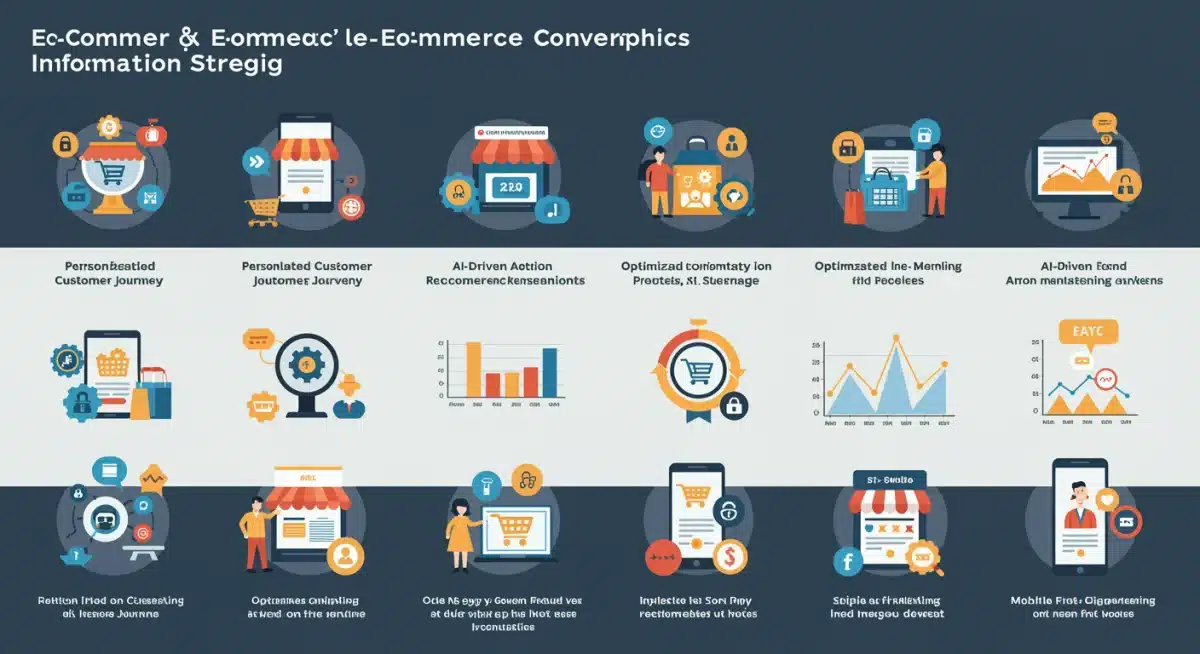New Trends in US E-commerce: 20% Conversion Rate Boost

Recent data reveals significant shifts in US e-commerce, with businesses leveraging advanced strategies to achieve up to a 20% conversion rate increase. Key drivers include hyper-personalization, AI-powered analytics, and seamless mobile experiences.
New Trends in US E-commerce: Achieving a 20% Conversion Rate Increase in 6 Months (RECENT UPDATES) are currently reshaping how businesses approach online retail. As of this week, market analysts are reporting a notable acceleration in conversion rates across various sectors, driven by innovative digital strategies and consumer behavior shifts. This surge highlights a critical period for retailers aiming to optimize their online presence and capture a larger share of the dynamic US e-commerce landscape.
The Rise of Hyper-Personalization in US E-commerce
Hyper-personalization is emerging as a dominant force within US e-commerce, moving beyond basic recommendations to create truly unique shopping experiences for individual consumers. This trend is not merely about addressing customers by name; it involves leveraging deep data analytics to understand purchasing patterns, browsing history, and even real-time behavior to tailor product offerings, content, and promotions. Businesses are finding that this granular approach significantly boosts engagement and, consequently, conversion rates.
The implementation of hyper-personalization often relies on sophisticated AI and machine learning algorithms. These technologies process vast amounts of customer data to predict preferences and customize every touchpoint in the customer journey. From dynamic website content to personalized email campaigns and targeted ads, the goal is to make each customer feel understood and valued, fostering loyalty and driving immediate purchases.
Advanced Personalization Techniques
- Dynamic Content Adaptation: Websites now change layouts and product displays based on individual user profiles.
- Predictive Analytics for Product Discovery: AI models suggest items a customer is likely to buy, often before they even search.
- Personalized Pricing and Promotions: Offers are tailored to individual elasticity of demand and past purchase behavior.
- Real-time Behavioral Targeting: Adjusting offers and messaging based on a customer’s actions during a single session.
AI and Machine Learning: Driving Predictive E-commerce
Artificial Intelligence (AI) and Machine Learning (ML) are no longer futuristic concepts but integral components of modern US e-commerce strategies. These technologies are providing businesses with unprecedented capabilities to analyze vast datasets, predict consumer behavior, and automate complex processes. The application of AI and ML extends from backend operations to customer-facing interactions, directly impacting conversion rates by enhancing efficiency and relevance.
One of the most significant impacts of AI and ML is in predictive analytics. By identifying patterns and correlations in historical data, these systems can forecast demand, optimize inventory management, and even anticipate customer churn. This proactive approach allows e-commerce businesses to make data-driven decisions that minimize waste and maximize sales opportunities. Chatbots and virtual assistants, powered by AI, are also improving customer service, resolving queries quickly, and guiding shoppers through the purchasing process, further contributing to higher conversions.


AI-Powered Optimization Areas
- Optimized Search and Recommendations: AI algorithms refine internal search results and product suggestions for greater accuracy.
- Fraud Detection and Security: ML models identify suspicious transactions in real-time, protecting both consumers and businesses.
- Automated Customer Support: AI-powered chatbots handle routine inquiries, freeing human agents for complex issues.
- Dynamic Pricing Strategies: Algorithms adjust prices based on competitor data, demand, and inventory levels.
Seamless Mobile Experience: A Conversion Imperative
With the majority of online traffic now originating from mobile devices, providing a seamless mobile experience is no longer optional but a fundamental requirement for success in US e-commerce. Retailers are prioritizing mobile-first design, ensuring that their websites and apps are not only responsive but also optimized for speed, ease of navigation, and intuitive user interfaces. A clunky or slow mobile experience can lead to high bounce rates and lost sales, directly impacting conversion figures.
Key elements of a superior mobile experience include fast loading times, large and easily clickable buttons, simplified checkout processes, and mobile-specific payment options like Apple Pay or Google Pay. Furthermore, progressive web apps (PWAs) are gaining traction, offering app-like functionality directly through a web browser, reducing friction for users who may not want to download a dedicated application. These advancements are crucial for capturing the on-the-go consumer and driving conversions.
Enhancing Mobile Commerce
- One-Click Checkout: Streamlining the purchase process to minimize steps and reduce cart abandonment.
- Optimized Image and Video Content: Ensuring media loads quickly without compromising visual quality on mobile screens.
- Voice Search Integration: Adapting to hands-free shopping trends, making product discovery more accessible.
- Location-Based Personalization: Offering localized promotions and inventory information for nearby stores.
Subscription Models and Recurring Revenue Growth
The proliferation of subscription models is a significant trend contributing to increased conversion rates and sustained revenue in US e-commerce. From curated boxes of goods to digital services and replenishment programs, subscriptions offer convenience and value to consumers while providing businesses with predictable income streams. This model shifts the focus from single transactions to long-term customer relationships, inherently boosting lifetime value and conversion consistency.
The success of subscription services hinges on delivering consistent value and a personalized experience. Companies are leveraging data to refine their offerings, ensuring that subscribers remain engaged and satisfied. The initial conversion to a subscription often represents a higher commitment than a one-time purchase, but the recurring nature of the revenue stream makes it a highly attractive strategy for e-commerce businesses looking to stabilize and grow their market share.
Benefits of Subscription Services
- Predictable Revenue: Creates stable income forecasts for businesses.
- Enhanced Customer Loyalty: Fosters ongoing engagement and reduces churn when value is consistently delivered.
- Data-Driven Personalization: More frequent interactions provide richer data for tailoring future offerings.
- Reduced Acquisition Costs: Focus shifts from constant new customer acquisition to retention.
The Impact of Social Commerce and Live Shopping
Social commerce and live shopping events are transforming how consumers discover and purchase products, directly contributing to higher conversion rates in US e-commerce. Platforms like Instagram, TikTok, and Facebook are no longer just for brand awareness; they are becoming integrated marketplaces where users can browse, interact, and complete purchases without leaving the social app. This seamless integration reduces friction in the buying journey, leading to more impulsive and frequent conversions.
Live shopping, in particular, leverages the power of real-time interaction and influencer marketing. Brands host live streams where products are showcased, questions are answered instantly, and exclusive deals are offered, creating a sense of urgency and community. This interactive approach mimics the in-store shopping experience, building trust and driving immediate sales. The authenticity and direct engagement inherent in social and live commerce are proving highly effective in converting viewers into buyers.
Key Social Commerce Drivers
- In-App Checkout: Enabling purchases directly within social media platforms.
- Influencer Collaborations: Leveraging trusted voices to drive product discovery and sales.
- Interactive Live Streams: Creating engaging shopping events with real-time Q&A and exclusive offers.
- User-Generated Content: Showcasing authentic customer reviews and product usage to build trust.
Optimizing the Checkout Process for Conversion Gains
A streamlined and secure checkout process is paramount for achieving high conversion rates in US e-commerce. Even with excellent product discovery and compelling offers, a complicated or insecure checkout can lead to significant cart abandonment. Businesses are now intensely focused on minimizing friction at this critical stage, implementing strategies that simplify forms, offer diverse payment options, and build consumer confidence.
This optimization includes clear progress indicators, guest checkout options, and transparent display of all costs, including shipping and taxes, upfront. Security assurances, such as trust badges and clear privacy policies, also play a vital role in reassuring customers. By removing obstacles and instilling confidence, e-commerce sites can significantly reduce abandoned carts and convert more browsers into buyers, directly contributing to the reported 20% increase in conversion rates.
Checkout Optimization Tactics
- Guest Checkout Options: Allowing purchases without requiring account creation.
- Multiple Payment Gateways: Offering a variety of payment methods, including digital wallets and buy-now-pay-later services.
- Progress Bars and Clear Navigation: Guiding users through each step of the checkout process.
- Trust Badges and Security Seals: Visually assuring customers of data protection and transaction security.
| Key Trend | Brief Description |
|---|---|
| Hyper-Personalization | Tailoring entire shopping experiences using deep data analytics and AI for individual customers. |
| AI & Machine Learning | Driving predictive analytics, optimized recommendations, and automated customer service. |
| Seamless Mobile Experience | Prioritizing mobile-first design, speed, and simplified checkout for on-the-go consumers. |
| Social Commerce | Integrating shopping directly into social media platforms and live events for direct sales. |
Frequently Asked Questions About US E-commerce Trends
Hyper-personalization involves using detailed customer data and AI to create highly customized shopping experiences. This goes beyond basic recommendations, tailoring content, product displays, and offers to individual preferences and real-time behavior to boost engagement and conversions.
AI and ML enhance conversion rates by enabling predictive analytics for demand forecasting, optimizing product recommendations, automating customer support via chatbots, and refining dynamic pricing strategies. These technologies create more efficient and relevant shopping journeys, leading to higher sales.
A seamless mobile experience is critical because most online traffic originates from mobile devices. Optimized mobile sites and apps, with fast loading times, easy navigation, and simplified checkout, reduce bounce rates and cart abandonment, directly improving conversion rates for on-the-go shoppers.
Subscription models contribute to higher and more consistent conversions by shifting from one-time purchases to recurring revenue. They foster long-term customer relationships, provide predictable income, and leverage data to offer personalized value, increasing customer lifetime value and retention.
Social commerce influences purchasing decisions by integrating shopping directly into social media platforms and live events. This reduces friction, allowing instant purchases. Real-time interaction, influencer marketing, and exclusive offers during live streams create urgency and trust, driving immediate conversions from engaged audiences.
What Happens Next
The current trajectory in US e-commerce indicates that businesses failing to adapt to these evolving trends risk falling behind. Experts predict continued investment in AI-driven solutions and further integration of social commerce, meaning these areas will be pivotal for future growth. Retailers should monitor emerging technologies and consumer feedback closely, as the landscape is set to undergo even more rapid transformation. The focus remains on creating highly personalized, frictionless, and engaging shopping experiences across all channels to sustain and build upon recent conversion gains.





